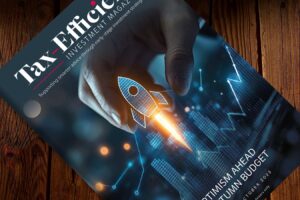How do you think financial markets can help in the journey to reaching net zero?
Fabiana Fedeli: I believe we are all responsible for helping to work towards a better world from a sustainability standpoint, and carbon intensity is clearly something we have to focus on. When you look at estimates, a huge amount of investment is needed to get us to net zero by 2050. This is obviously something that many of us want to contribute to and, while a challenge, it’s also an opportunity. An opportunity to participate in this new wave of investment. Which companies will do well? It will not just be the companies that are already closely aligned to climate factors and carbon intensity and efficiency, but also the companies in less “exciting” sectors that have typically not been associated with climate or sustainability, but that are learning to do things more efficiently from an environmental standpoint. These companies will open up new markets, and will appeal to a wider set of consumers.
Until now everything has been about the US, driven by technology. There’s no doubt that US tech remains important and has a strong outlook for the future. However, there is another market with a very long tradition in sustainability – and that’s Europe. I think that this is an opportunity for European companies – with many having been involved in sustainability for a long time – to, increasingly, appear on the radar of investors internationally.
Governments have spent a huge amount since the pandemic first hit. Can private and alternative assets fill the void where governments cannot, and where are the opportunities?
Will Nicoll: Is there enough money in private markets to cover for a lack in government spending? No. It’s important to think about why private assets have been on the run that they’ve been on for the last decade. There have been two main drivers: one is that yields in the rest of the economy aren’t that exciting, and so investors have been turning to alternatives. The other driver, which is more prevalent in Europe and Asia than in the US, is that the banking sector is retrenching. There is an enormous number of assets that have been sitting in banks – probably incorrectly – for the last 20-30 years, and these have started to come into private markets. Whether you’re talking about consumer mortgages, direct lending to companies or lending on buildings, there are a range of debt markets that have grown out of that. If governments go into reverse and if interest rates go up, then you’ve lost one of the main pillars that has driven people to alternatives – because if you can get a better level of return from lower risk short-term bonds, then that changes the way you look at private debt. So, with that in mind, the pandemic will have an impact on private debt markets.
However, the main structural ideas haven’t changed. Banks are still retrenching in Europe, so new markets continue to be developed. Alongside this, there is a revolution in how people want to invest their money and what they want to achieve with that, particularly in the last few years. As a result, we’ll see more smaller companies and that is bound to drive more interest in private equity and in pre-IPO equity – parts of the market that can grow quite a lot in the next few years.
So, if you’re looking at “old style” private markets then they look a lot more like public markets. But there are new markets coming up all the time, from this bank retrenching and changing investor behaviours, and those will still end up offering interesting opportunities. And the governments were never there anyway – it’s only in those “old style” markets that you see government money having to come in, and the rest tends to be predominantly privately funded.
The scope of alternative and private assets continue to increase, from cryptocurrencies and non-fungible tokens (NFTs)s, to music rights. What different skill sets and expertise do asset managers need to understand this evolving opportunity set?
Will Nicoll: This is not particularly different to what has been happening over the last 20 years. We have seen new asset classes coming through all the time, and as long as there is a cash flow attached to them, then you can start analysing them as potential opportunities. With music and film rights, there is clearly a cash flow there. But if you look at assets like NFTs, then it’s very difficult to see what cash flow an investor could get – and that is therefore a more speculative market. I don’t think areas like cryptocurrency and NFTs are necessarily going to be interesting to asset managers like us – when we need to be able to value something and look longer term. A technique in a technology like blockchain, however, could be fascinating in terms of developing the markets and making everything significantly more liquid – which would have a massive impact both on public and private markets.
What would you consider the key risks for 2022?
Fabiana Fedeli: We have highlighted some of the obvious risks – including inflation, COVID-19 and the potential for a policy error. However, another significant risk is likely to be regulation. Also, governments have been spending a lot of money trying to get everyone out of a very deep hole during the pandemic, so taxes could be another consideration. And lastly, a key risk to look out for will be how different companies are going to deal with supply bottlenecks and inflation.
Will Nicoll: Regulation and government activity is more muscular than it has been in terms of the markets for quite a long time. The new European Sustainable Finance Disclosure Regulations (SFDR) are positive, by requiring asset managers to classify their ESG products under Article 8 or 9, for example. However, the rules do mean that now everybody wants to have the most impactful and the most ESG-friendly ideas – and there may not be enough assets to feed that demand. So regulation is having an enormous effect and that is what shifts markets in a way that is impossible for us to predict. If we are trying to be sensible long-term investors, the risks are when something comes in completely from leftfield, and changes the whole basis of the game we were playing.
Jim Leaviss: I think the biggest risk is super-fast growth and that the wave of unleashing isn’t transitory – that this is something more deep seated. There is a risk that growth absolutely gangbusters globally in 2022 and that will leave a very difficult situation for policymakers by the end of the year.








![[UNS] tax](https://ifamagazine.com/wp-content/uploads/wordpress-popular-posts/788955-featured-300x200.webp)
![[uns] house of commons, parliament](https://ifamagazine.com/wp-content/uploads/wordpress-popular-posts/788873-featured-300x200.webp)




